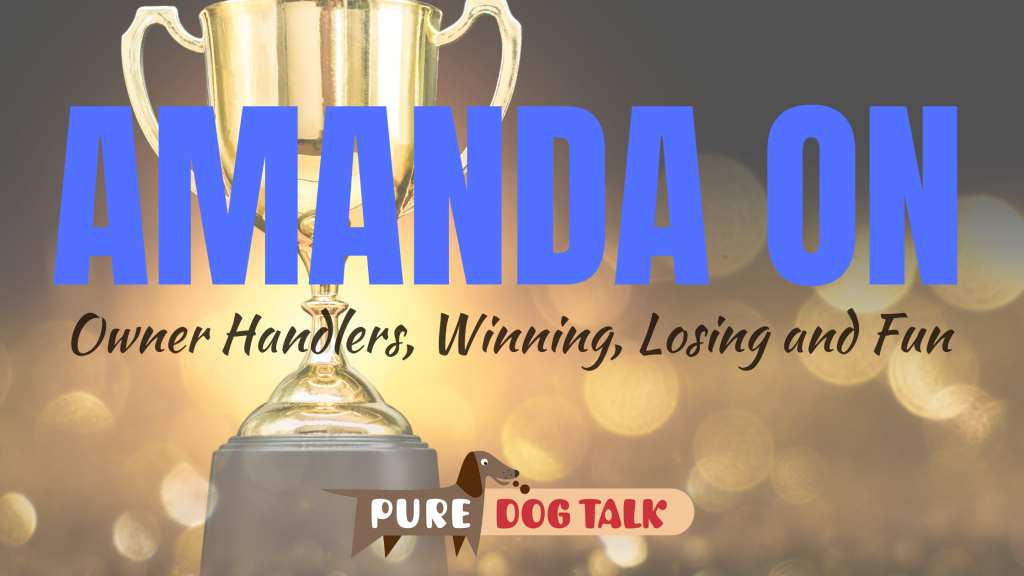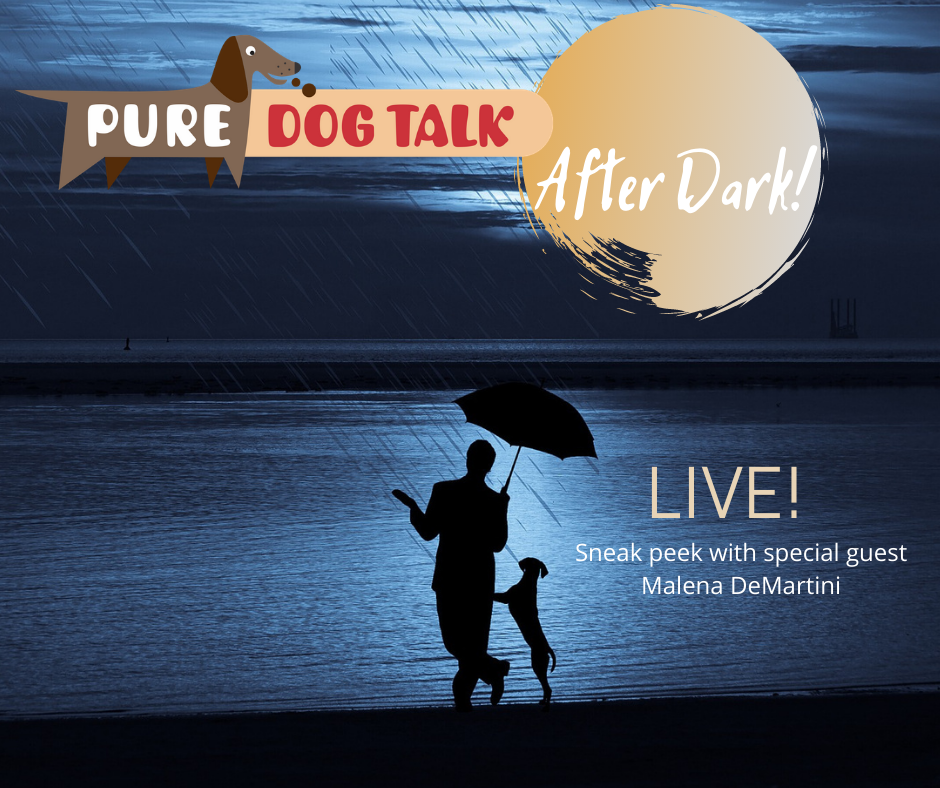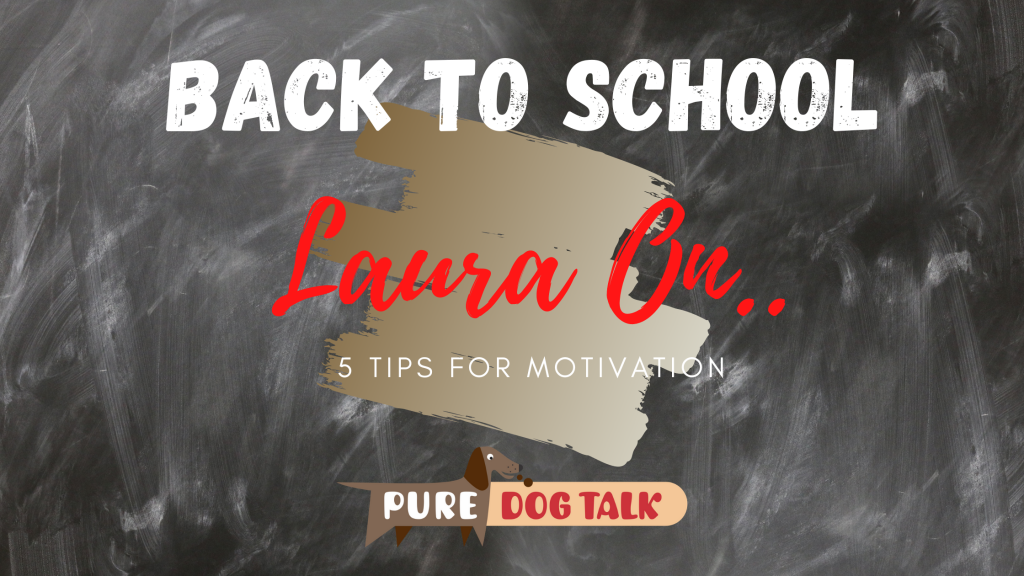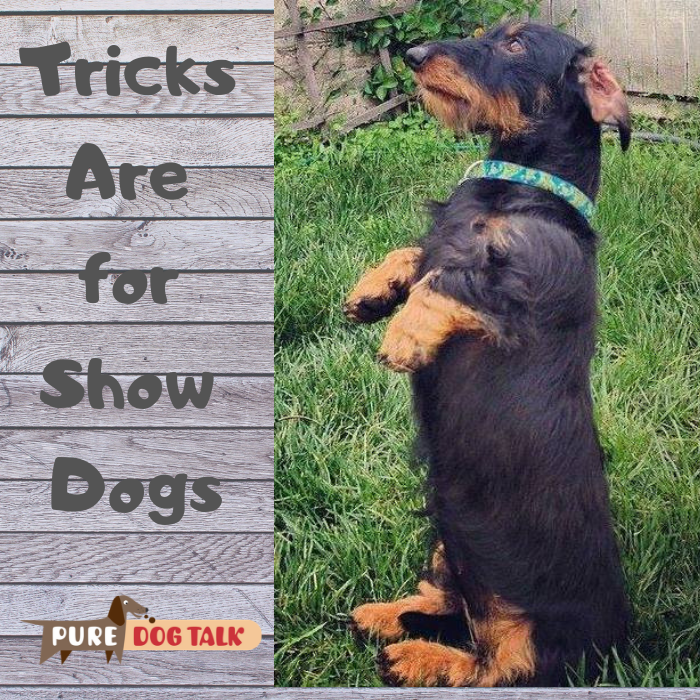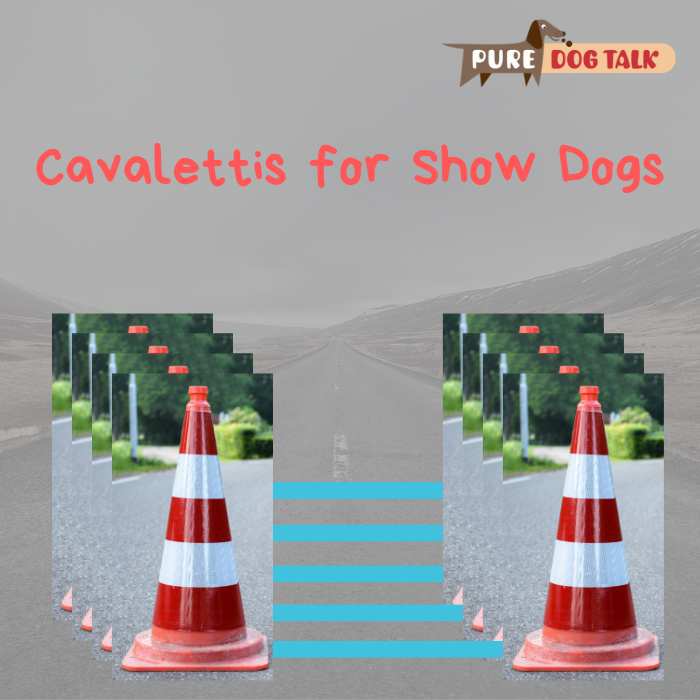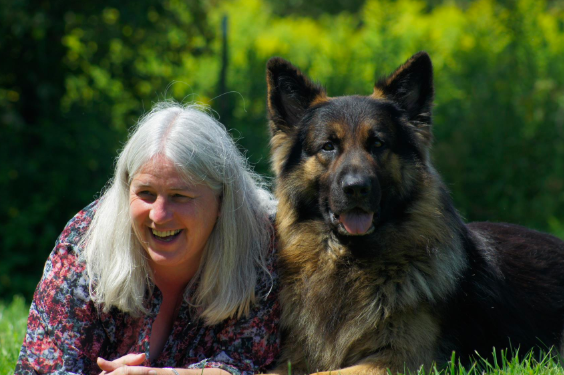495 — Amanda On… Owner Handlers, Winning, Losing and Fun
Amanda On… Owner Handlers, Winning, Losing and Fun
Amanda Kelly, breeder-owner-handler of Fwaggle Toy Manchester Terriers in Canada, joins host Laura Reeves for a pragmatic, insightful and realistic discussion on the challenges and assets owner handlers bring to the competition.
“You really need to examine how are you viewing winning and losing as a first step,” Kelly noted. “And secondly, in addition to how you’re viewing winning and losing, you also, I think, need to start with realistic goals of what you want to achieve.
“You are not being realistic if you have your very first show dog … you’ve never groomed a dog, you’ve never shown a dog, but you want to be the number one Cocker spaniel in the United States … that’s not going to happen. It’s just not. It could be the greatest Cocker Spaniel that ever lived and it’s not gonna happen.
“We all recognize that there’s a kind of an innate imbalance there (between professional handlers and owner handlers). Let’s talk about how people can fix it. Because if you didn’t have any hope of ever being able to overcome it, then why would you bother to enter and go to the show?
“I think the best thing that you can do is to find yourself a really great class. Find yourself a really great mentor. If there’s no classes in your area, there are tons of online classes and opportunities to be mentored by professionals at a distance.
FUN is job #1
“Your number one job is to make sure that, whatever it is that you choose to do in the ring with your dog, that it’s fun for your dog. I see so many people who are so concentrated on their dog being perfect that they practice them to death by boredom. The dogs just start to hate it. So my own tip for people whenever they ask me, ‘what can I do to help make my dog stand out,’ I always say make sure that your dog has an arsenal of tricks.
“Behavior training for the ring is just trick training. Every single thing that we want them to do when you walk into the ring is no different than you teaching your dog to sit, or rollover or sit up and beg or spinning a circle. They’re all tricks, (even if) some of them are a little bit more complicated tricks.
How do you eat an elephant? One bite at a time…
“The greatest gift you can give yourself is, first of all, patience with yourself and the greatest thing (you can give your dog) is patience with your dog. The second thing you can give yourself is to find a good teacher who can help you teach yourself and your dog the behaviors that are involved in showing in bite sized pieces that you can actually eat and have some success with. If you try to do everything all at once you are going to get discouraged and you’re going to stop.”
479 – Anxiety, FOMO or Frustration?
Anxiety, FOMO or Frustration?
Malena DeMartini on Ringside Anxiety Management – After Dark Special
Join host Laura Reeves and special guest Malena DeMartini for a sneak peek inside the Pure Dog Talk Patrons After Dark virtual gatherings.
This month our group was able to speak directly with DeMartini, canine behavior expert specializing in separation anxiety. We’ve brought you a bit of an excerpt. If this seems like your kind of group, join us by submitting your Patronage pledge here.
DeMartini walks us through signs owners can watch for that will help them determine if their dog is experiencing anxiety, FOMO (fear of missing out) or frustration ringside or in daily life. She specifically separated the behaviors associated with each of these mental states and then offered suggestions on how to manage each one.
Group members were able to join in the conversation virtually and receive specific advice from DeMartini about various situations with specific dogs in their households. From mild FOMO to significant arousal near other dogs, DeMartini talked us through several of her processes for addressing the issues at hand.
DeMartini and Patron Sandy MacArthur, a 30-year veterinary technician, discuss the pros and cons of treatments for anxiety, primarily discussing various homeopathic remedies. DeMartini noted that for dogs with classic separation anxiety, these are like pouring chamomile tea on a human with a sleep disorder.
“I do believe that training can be very effective,” DeMartini said. “What we did 20 years ago versus what we do now is very different.
“Dogs don’t particularly generalize well. So, if I teach my dog to stack only in my living room and then I expect to go into the show ring. Good luck with that. I think that sometimes we forget that a little bit when we talk about bringing them to different environments. When it comes to anxiety, whether that’s in a crate, whether that’s out of the crate, if people are the general simulators that are influencing your pup, then that needs to be worked on well before you get to a show ring.”
We hope to see YOU After Dark next time.
433 — Five Tips for Staying Motivated During Uncertainty
Five Tips for Staying Motivated During Uncertainty
The global Coronavirus pandemic has brought with it a plethora of change. Staying motivated to train, groom and condition our dogs has been a challenge.
Event cancellations, isolation, quarantine, toilet paper hoarding and stay at home orders crashed down on all of us in March. And here we are, nearly seven months later. A few events of various types have been held around the country since this summer.
The purebred dog fancy has generally been careful to follow all mandated precautions at these events (More on this next week in my conversation with handler Bill McFadden) in order to encourage more events to resume. A great many more events have continued to be cancelled for any number of reasons.
Exhibitors are frustrated. Exhausted by the ups and downs. It can seem daunting and pointless to maintain our usual routines when there is no identifiable goal. The finish line is uncertain and hazy off in the distance.
My regular listeners know my “penchant for Polyanna” … a tendency to focus on finding what sliver of a silver lining shines through any storm … a lemonade out of lemons mentality that helps keep me grounded.
With that, here are five tips for staying motivated in your training, conditioning and grooming plans.
Win the War on Weariness
We are all tired. Tired of home schooling and masks and no hugs. Exhausted by national politics and worried about money, health, and the future. Weary of the unending unfolding nightmare that 2020 has come to represent to nearly everyone.
One guess as to the best medicine for this type of fatigue and burnout… Yep. Dogs. EVERYONE is either buying or attempting to buy a new dog. We have all seen the registration numbers going up and our inboxes flooded with puppy requests.
So, if John Q Public sees the benefit in acquiring a new best friend, *clearly* we dog people are ahead of the game! We often have *multiple* dog households! We have dogs to snuggle, to listen to our darkest fears. We have dogs to distract us, get us off the couch, away from the fridge and keep our blood flowing.
Celebrate “man’s best friend” and all she represents to you by practicing your stand stay, your send out, your watch me. Whatever your discipline, there are games you can play to keep your dog sharp and your muscle memory intact, while simultaneously beating back the looming grey clouds hanging around our heads. I’ll include links in the blog post to previous podcast episodes with some good doggy conditioning exercises. Listen here and here and here.
Working from home, home schooling and limited social outlets can feel chaotic, confused and disorderly. One of the few things you can absolutely take into your own control is the time you spend with your dog. Whether you choose to carve out an hour a day for training, trimming, trotting or simply tears behind closed doors, you are in charge of that. And our dogs are always up for the attention and the time spent together.
That small measure of being in control of SOME damn thing is a major component of defeating depressed moods and being better able to cope with rest of the daily aggro.
Prevent Pandemic Pounds and Pandemic Puppies
While we’ve all been eating — and possibly drinking — our feelings during the last seven months, our young dogs have had nearly zero socialization opportunities. Our motivation to improve our dogs’ future success can provide the kick in the pants we need to get up off the couch, push back from the dinner table and head for the grooming table.
Even if you have to wear a mask while doing it, walking around the neighborhood is allowed everywhere. Walking or running or biking with your dog will keep both of you fit and ready to handle whatever comes next, including fitting into show clothes …
Innumerable studies have proven conclusively that the more physically active we are, and the more time we spend with our dogs, the healthier we are physically AND mentally. The healthier we are, the safer we are from ALL types of viral infections.
Socialization is tough in these times, but even getting your dog out and walking around the parking lots of the stores that are open allows them to see and hear new sights and sounds. Varying surface texture — from gravel to concrete to grass to dirt to asphalt — is critical for young puppies once they are vaccinated and able to be on the ground. That can be done outdoors in a safe and socially distanced way.
Car rides to open spaces are excellent opportunities for training and socializing to new environments. Check out the podcast on Sniffspot to find spots in your area where you can run or train your dog safely off-lead without fear of germs, for you or your dog, or encountering uncontrolled dogs.
Build the Bond
One of the most valuable results of spending time training your dog, or grooming or conditioning, is building the unshakeable bond of trust that our dogs crave.
Every time we reinforce “watch me” for eye contact, every time we use our quiet hands to calm their excitement, every single time we work through a knot in their coat or pull coat in wire coated breeds or run a clipper or a Dremel, every time we take off on a loose lead walk or jog, we are teaching our dogs.
Every single interaction between us and our dogs is an opportunity for us to teach and mold them…. Or, conversely, for them to learn that our cues are meaningless and it’s easy to blow them off and do their own thing.
I repeat. EVERY interaction with your dog is a training opportunity. Of either them or you. Choose wisely! Dogs respond to affection, to food, to toys, but mostly to trust.
If the dog knows you won’t hurt him or allow him to be hurt, if the dog TRUSTS that if you give a verbal or non-verbal cue it means the same thing every time, if the dog is 1000 percent confident in you as the lead dancer in your performance, whatever event it might be, you will be miles ahead of your competition. Even when your puppy hasn’t had all of the “hands on” socializing and people interaction you would prefer due to the pandemic.
I recently attended the very first west coast dog show since March with my own personal pandemic puppy. Agatha is a Spinone Italiano… The litter was born the day they shut down Louisville. I’ll never forget her birthday… The breed in general and this individual dog tend to be a bit hesitant with strangers.
We have worked at it, but getting enough “hands on” has been a struggle. The only handling class we could make it to, I was teaching. Her co-breeder/co-owner brought her and I worked with her a few minutes. But that was *literally* her only practice before the shows in Washington last month.
PS it was the worst dog show weather known to man. Raining sideways in torrents, wind, blowing tarps flying, gallons of water being dumped off tents inches from her nose, raincoats, rainhats, masks, gloves, barking dogs and weirdness at every single turn, from her perspective.
She wasn’t perfect, she melted on exam. She *leeeeeeeeeeeeaned* on exam. She wasn’t sure what the heck to do with a dog running behind her. But she trusted me. She stood up, shook it off and wagged her tail after every encounter. She moved head and tail up, stacked on the line, considered free stacking before she was just toooooooo distracted. She won. She wasn’t perfect, but she trusted me.
I was soooooo proud of this little dog who had to suck it up in the very worst of conditions for her first actual dog show. Trust, along with all of the things that we COULD do, made the difference.
One thing that I made clear going in. The dog show was five days. If I felt she was becoming overwhelmed or having a bad experience, I would walk away. As it turned out, a crisis at home cut our week short and I wasn’t sad.
I think it’s important to remember the old axiom, always end a dog’s experience with anything on a positive. Don’t push young dogs to do more than they can handle. If you eat an entry fee, it’s a small price to pay for not blowing the dogs brain up and ruining it for the long run.
Find the Fun
Wait for it….. This is, or it’s supposed to be, fun! Whether you are showing your dog, running fast CAT, barn hunt, agility or a field trial, it’s OK to have a good time! Competition is great. It keeps us sharp and striving to succeed and improve. But as soon as you aren’t having a good time, rethink what you’re doing. Because if you hate it, the dog definitely does.
I just had a young woman tell me this exact story about a dog show a few weeks ago. Her dog lost, she felt her dog was a better example of the breed, but her dog moved head and tail down in true Eeyore fashion. She admitted that she was sooooo not interested in being there and that it traveled directly down the leash to her dog. Which caused her to lose and become more frustrated. This vicious cycle can happen to ANY of us.
Remember, our dogs count on US to be the fearless leader. Their knight in shining armor. Their Princess Bride. It’s why it’s so critical to get YOUR head space right before you try and ask the dog for a *performance*…
When you can take away the ribbon part. Focus on your partnership with your dog. Quit worrying about blue or white. Just concentrate on the dog in front of you. On getting inside that dog’s head. On pouring confidence and strength right down the lead and into their bodies. Make sustained eye contact. Communicate on a private level. Quit jacking your jaws with friends and competitors ringside and inside the ring and completely concentrate on your dog. THEN you will be able to find joy. To find power. You may or may not win, but you sure the heck will have fun with YOUR DOG!
Because It’s All About the DOGS
This final point is one I see waaaaaaaaaay too often left behind. Walked past. Ignored. Don’t know what you’re talking about.
In the race for points or rankings or notoriety or whatever one hopes to gain from dog events, folks have a painful tendency to forget the dog entirely. They lose, so they yank the dog around. The dog fidgets, so they yell at the dog. They’re so busy jacking their jaws about the unfairness of professional handlers or politics or mean girls or whatever has them all busted up on the given day, they pay NO attention to the dog… Is it spooked? Doesn’t feel good? Uncertain? Jacked up? Mad? Who knows! Exhibitors of this stripe rarely even look down the leash, never mind feel the vibe up it from the dog.
It’s About the Dogs. Period. End of discussion. You have paid someone for an opinion and received it. If you didn’t like it, step back, like my friend did, and figure out why. If you aren’t willing to do that, you are doing the DOG a giant disservice.
Bad things happen when you are focused on YOU and not on the DOG. It can be a small bad thing, like losing out on a ribbon. Or a very large bad thing, like losing a dog. I can’t say it often enough or loudly enough. The DOGS are why we do this. The DOGS come first. In EVERYTHING. EVERY time. If that is too hard, perhaps you should consider goldfish instead.
So, in the final analysis, our *motivation* is always the DOGS. There will be a next year. Or the year after. There will be another dog event. There might even be another dog. But there will never again be THIS dog. So, find your mojo. Give her the best you have of time, training, grooming, conditioning and effort. Build your bond with your dogs. And, for the love of all that is holy, have FUN!
322 – The Winning Edge! Panel Discussion With the Masters
The Winning Edge! Panel Discussion With the Masters
Host Laura Reeves moderates a Friday Night Forum Panel Discussion on the topic of the “Winning Edge” with Judges Rick Gschwender and Pluis Davern and Professional Handler Bill McFadden.
It is not the judge’s job to find a “diamond in the rough,” Reeves posits. “Polish your “gem stone” for your best chance of success.”
Good habits
 Gschwender starts the discussion by asking the audience about their habits with the dogs they exhibit.
Gschwender starts the discussion by asking the audience about their habits with the dogs they exhibit.
“How many of you train your dog? Road work him? Take video to see what the judge sees? Clean their teeth?” Gschwender queried. “I see people all the time, they’re paying $30 to enter the dog and haven’t even cleaned teeth.”
Gschwender adds, “Watch the judges. If you pay attention, you will see consistency in what they put up. You might not like it, but you will figure out what I like and come back and show that to me.”
Motivated by motion
Davern noted, in a fascinating observation, that people are *predators.* Which means “we are motivated by motion. What are judges looking at?” Davern asked rhetorically. “Motion. It catches the eye. You can *subtly* move your hand to show a pretty head, for example.
“You’re in the ring, you’re all showing the same “product.” There’s 20 boxes of cornflakes. What makes yours better than the others?”
Owner handlers have a huge advantage, Davern said. They are spending time with the dog they love.
“This is a great sport! Nobody takes a golf club to bed at night,” Davern said. “Life is not all about winning.”
Be prepared
“Take a deep breath and don’t rush,” McFadden advises. He also notes that in some cases, owner handlers who are long time breeders are “experts showing to novices.” Judges are life-long learners and may be new to a breed. “Present your breed the way it should be shown.”
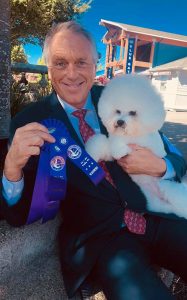 Most importantly, McFadden said, be prepared. “Make sure your dog is in condition, physically, mentally, emotionally.”
Most importantly, McFadden said, be prepared. “Make sure your dog is in condition, physically, mentally, emotionally.”
“You’ll have successes and failures you deserve and ones you don’t. It happens to handlers too. We show 20 dogs and might win with two,” McFadden added.
For more insight from a couple of these panelists, you can listen back to:
https://puredogtalk.com/10-bill-and-taffe-mcfadden-live-at-akc-nationals-wisdom-wednesday-2/
https://puredogtalk.com/34-sussex-spaniels-hunt-tests-search-and-rescue-pluis-davern-tells-all-2/
https://puredogtalk.com/35-dogs-to-the-rescue-firefighters-first-responders-and-pluis-davern-2/
321 — Tricks Are for Show Dogs! Improve Focus in the Ring
Tricks Are for Show Dogs! Improve Focus in the Ring
Show Dog Prep School founder, Vicki Ronchette, provides tips for training tricks to show dogs to help them focus and have fun.
“Training tricks is fun,” Ronchette said. “People and dogs enjoy it more than they do training traditional exercises. It is relaxing. And it’s a good way for people to improve their mechanical training skills.”
Dogs get bored in the ring, Ronchette noted. Having a repertoire of tricks available helps dogs and exhibitors relax, she said.
Bonus, the dogs and handlers having fun makes a good impression on audience and serve as crowd pleasers. Note the phenomenal success of the “sit up” by the Sussex Spaniel, Bean, at the 2018 Westminster Kennel Club show.
Ronchette shared a few of her favorite “tricks” to teach clients that provide specific benefits to dogs and their performance.
Touch!
Target training is a favorite of Ronchette’s. She trains the dog to touch its nose to her hand.
“It’s so beneficial,” Ronchette said. “It’s easy to teach. And when you have a distracted dog, it gets their attention.”
Sit Pretty
Sit up and beg can be a controversial trick, as some feel it can be harmful to the dog’s back. Other trainers argue it is indispensable core conditioning that strengthens back muscles. Either way, that super cute “begging” for attention is a sure fire winner.
Get on top
Teaching the dog to get up on a big rock, grooming table or other high perch, Ronchette says, is a great confidence builder. “They need to own these behaviors,” she noted.
AKC’s Trick Dog program allows owners to put a fun title on the end of the dog’s name, Ronchette noted, helping them “get their feet wet in something other than conformation.”
To learn more about the origins of the Trick Dog program, take a listen to my interview with AKC’s Doug Ljungren, the program’s biggest advocate.
128|Doug Ljungren is Up to Tricks…Trick Dogs|AKC VP of Sports and Performance|Pure Dog Talk
319 — Cavalettis for Show Dogs with Vicki Ronchette
Cavalettis for Show Dogs with Vicki Ronchette
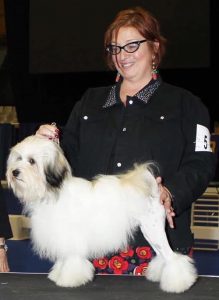
Vicki Ronchette with her Lowchen.
Show Dog Prep School founder Vicki Ronchette shares her tips and tools for using cavalettis to train body awareness, conditioning and more.
Cavalettis, Ronchette said, are useful for a variety of issues. Dogs who pace, forge on the leash, need to know where to put their feet amongst other topics are well served by practicing with caveletti training.
One of the most common uses is to build muscle memory to increase reach and extension, Ronchette said. “Most dogs love doing the cavalettis,” she added.
Using simple, inexpensive materials, Ronchette provides direction for building and utilizing these obstacles in an exhibitor’s “tool kit” of preparing the dogs for the show ring.
How To’s and Why For’s
One of Ronchette’s most frequently asked questions is how far apart to set the poles for proper gaiting. She said she measures from the front toe to the back toe when the dog is in a comfortable stack. That is the “elementary” distance the poles are placed apart. As the dog gains skill and confidence, the poles are moved further apart to make them the dog increase its stride.
“We’re asking these dogs to be athletes in the show ring,” Ronchette said. “It’s more than just walking around. It’s walking around and looking fabulous.”
One specific training opportunity Ronchette uses the obstacles for is to teach not to chase other dogs. “I make them concentrate on foot work instead of chasing,” she observed.
“I strongly believe that if there is any physical limitation the dog is aware of it and it increases anxiety,” Ronchette said. “When you do these type of exercises, the dog ‘owns’ that behavior and it creates confidence. Confidence changes a dog’s carriage.”
Ronchette’s course at Show Dog Prep School.
Canine Conditioning with Dixie Rae Sick.
251 – Trainer Suzanne Clothier on Relationship Building with Your Dog
Suzanne Clothier Talks Relationship Building
Suzanne Clothier has developed a training and assessment system built entirely around relationship building with our dogs.
“Animals have been my whole life,” Clother said. “It’s a lifelong passion, that has informed a fascinating journey.”
Clothier’s seminal book, Bones Would Rain from the Sky, was published in 1998. Her warm, down to earth, compassionate nature shines through as she shares her journey and what she’s learned.
Relationship building
“If you have a trusting relationship,” Clothier said, “it’s then about what you enjoy doing together.”
Training show dogs is a skill like any other, Clothier noted. She added that not all dogs have “the Sandra Dee gene” that makes them enjoy being the center of attention.
“We’re like crazy stage moms,” Clothier said, “asking our dogs to be on stage.” For dogs who train well at home but don’t give us the performance we’re expecting at a show, “It’s like singing in the shower,” she noted, “It’s not the same as auditioning for The Voice.”
Clothier’s goal is to evaluate all interactions with a dog through the prism of “How does this affect the relationship with me and the animal.”
Tools for the job
Her training goals are to stay humane, fair, loving and respectful, Clothier said. She has developed tools for trainers to help diagnose both handlers and dogs.
Her Relationship Assessment Tool helps clarify “which end of the leash is contributing to the problem,” Clothier said. “What do I need to fix. And where’s the good stuff. What can we build on.”
She’s also created an ap, to be released this month, that enables owners, handlers and caretakers to literally track exactly how a dog is feeling on a given day. This Functional Assessment Tracking program provides feedback using the dog’s behavior, activity, food intake etc to determine, literally, “how are you today.”
For more information, visit:

